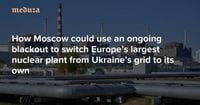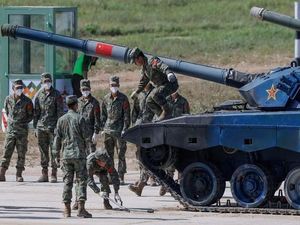The Chernobyl Nuclear Power Plant, long synonymous with disaster and resilience, found itself thrust back into global headlines this week after a Russian drone attack knocked out electricity to the site for more than three tense hours. The incident, which unfolded on October 1, 2025, was part of a broader escalation of hostilities targeting Ukraine’s critical infrastructure, raising fresh alarms about the safety of nuclear facilities in war zones and the growing risks of radiological incidents.
According to Ukrainian officials and the International Atomic Energy Agency (IAEA), the blackout at Chernobyl began when over 20 Russian drones struck the city of Slavutych, home to the substation that supplies power to the plant. President Volodymyr Zelensky, in a statement posted to social media, called the attack "deliberate" and accused Russia of intentionally creating a risk of nuclear catastrophe. "Some of these drones were shot down, but the attack was specifically executed as a wave to complicate the facility’s defense," Zelensky said, as reported by Anadolu Agency.
The power outage plunged the New Safe Confinement (NSC)—the massive steel structure built in 2016 to isolate the destroyed fourth reactor—into darkness, forcing the site to rely on emergency diesel generators. The blackout also affected the spent fuel storage facility, which contains more than 3,250 tonnes of radioactive material. The quick activation of backup lines prevented the situation from spiraling out of control, and, by late evening, Energy Minister Svitlana Hrynchuk announced that power had been fully restored to all Chernobyl facilities. "Radiation levels did not exceed control levels and there were no threats to the local population," she confirmed, according to multiple Ukrainian sources.
The IAEA, through Director General Rafael Grossi, verified that the blackout had occurred and praised the swift response of Ukrainian engineers. "The facility quickly switched to backup lines, and power was restored, with the exception of the New Safe Confinement, which is being supplied with electricity using two emergency diesel generators," Grossi said in a statement cited by Mezha and Anadolu Agency. He added that all other facilities remained powered and that the radiation background was under control.
This latest episode is not the first time Chernobyl has been caught in the crossfire since Russia’s full-scale invasion of Ukraine in 2022. Russian troops occupied the site in the early weeks of the war, only to withdraw after several weeks of tense standoff. Earlier this year, in February, one of the plant’s protective shells was struck, causing a small fire but no increase in radiation levels. The exclusion zone surrounding Chernobyl, stretching 30 kilometers in all directions, remains one of the world’s most heavily monitored areas, with constant power required to cool spent nuclear fuel and maintain radiation surveillance.
While the immediate threat at Chernobyl was swiftly contained, the incident has reignited debate over the vulnerability of nuclear sites in active conflict zones. President Zelensky did not mince words in his call for international action, warning that "Russia is intentionally creating a risk of radiological incidents, taking advantage, unfortunately, of the weak stance of the IAEA and Director General Rafael Grossi, as well as the dispersed global attention." He urged European countries, the United States, and members of the G7 and G20 to take "real action for peace and security to the fullest extent possible," insisting that only "strong response and appropriate pressure on Russia" could protect human life.
The blackout at Chernobyl was not an isolated event. Just days earlier, the Zaporizhzhia Nuclear Power Plant—Europe’s largest—had been cut off from Ukraine’s grid and forced to rely on emergency diesel generators for cooling. The outage, which began on September 23, 2025, has persisted for more than a week, with both Ukrainian and Russian officials trading blame. Ukrainian authorities accuse Russia of shelling the facility, while Russian officials point the finger back at Ukraine. However, a Greenpeace investigation published on October 1 found "no signs of major damage" to the power lines, suggesting the blackout may be a "deliberate act of sabotage by Russia," as reported by Meduza.
Greenpeace alleges that Moscow’s aim is to permanently disconnect Zaporizhzhia from Ukraine’s power system and integrate it into Russia’s grid. Supporting this claim, The Guardian reported on an unpublished Russian document submitted to the IAEA, outlining procedures for transmitting voltage from Russia’s unified power system if the plant is separated from Ukraine’s grid. The Russian-installed director of Zaporizhzhia, Yuriy Chernichuk, stated last week that reintegration into Russia’s grid was "in its final stages." Ukrainian Deputy Foreign Minister Andriy Sybiha accused Moscow of preparing to "steal the plant," warning that such a move would lead to "the irreversible collapse of the peaceful nuclear order established by the IAEA."
Nuclear energy expert Dmitry Gorchakov, speaking to Novaya Gazeta Europe, downplayed the immediate risk of a meltdown at Zaporizhzhia, noting that most reactors have been in "cold shutdown" for over two years and require only minimal cooling. "After shutdown, the reactors still generate heat, but the amount gradually decreases. Now it’s very little, and only a small amount of water is needed for cooling," Gorchakov explained. He contrasted the situation with the 2011 Fukushima disaster in Japan, where reactors had been operating at full power before losing cooling. Nevertheless, Gorchakov warned that the greater danger lies in Russia potentially using the threat of a nuclear incident as a pretext to justify connecting the plant to its own grid—a move that could have far-reaching geopolitical consequences.
The IAEA’s ability to independently verify the situation on the ground remains limited. Its personnel have been present at Zaporizhzhia since September 2022, but, according to Gorchakov, "they aren’t even being allowed to inspect the site where the power line was damaged. Russia is manipulating the agency—and doing it very effectively." The international community faces a dilemma: any Ukrainian attempt to disrupt Russian control over Zaporizhzhia could be framed by Moscow as endangering nuclear safety, while acquiescence could set a dangerous precedent for the seizure of civilian nuclear assets in wartime.
Back at Chernobyl, the restoration of power and the absence of elevated radiation levels have provided a measure of relief. Yet, as Ukraine’s nuclear facilities remain in the crosshairs, the risks posed by military strikes on such sites are becoming increasingly difficult for the world to ignore. The events of October 1 serve as a stark reminder that, even decades after the original disaster, Chernobyl’s legacy continues to haunt not just Ukraine, but the entire international community.





